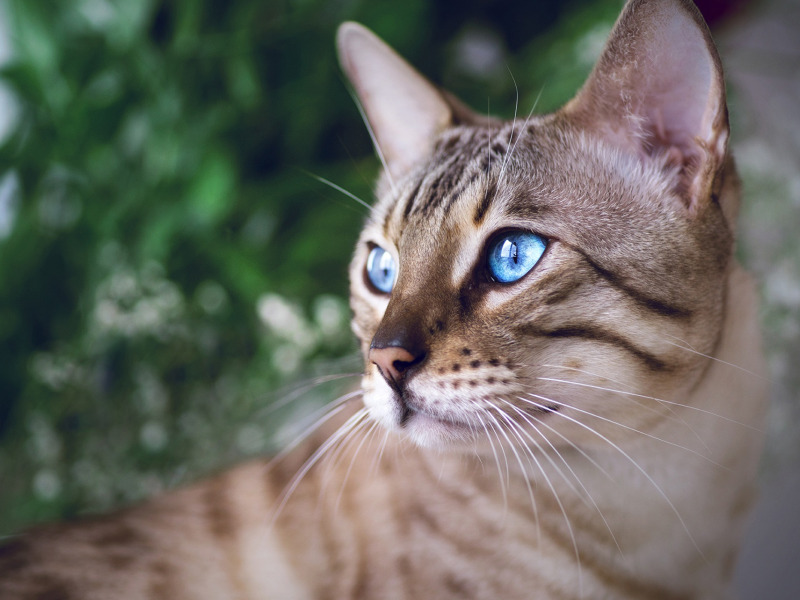The Bengal cat breed stands out in the feline world for its remarkable coat that mimics the appearance of wild leopards. Known for their vibrant energy and playful nature, Bengals offer a unique combination of exotic looks and domestic temperament. This breed is not only captivating in appearance but also in intelligence, often demonstrating a keen interest in interactive toys and puzzles. Their athletic build enables them to perform impressive leaps and sprints, making them a dynamic addition to any household. For those seeking a pet that combines the allure of a wild animal with the affectionate traits of a family cat, the Bengal breed presents an intriguing option. Understanding their needs and characteristics is essential for fostering a harmonious living environment.
Key Takeaways
- Bengal cats are a distinctive and active breed, requiring owners who can engage with their high energy levels and intelligence.
- Regular health check-ups and a proper diet are crucial for maintaining the well-being of a Bengal cat, highlighting the importance of understanding their specific health needs.
- Creating a stimulating environment with plenty of space to climb and explore is essential for the happiness of a Bengal cat, reflecting their wild ancestry.
- When considering adding a Bengal cat to your family, it’s vital to research reputable breeders or adoption centers that can provide a healthy, well-socialized kitten.
- Bengal cats thrive in environments where they can form strong bonds with their owners, making them an excellent choice for those willing to invest time in interactive play and companionship.
- Understanding the unique characteristics and needs of the Bengal cat breed is key to providing a loving and suitable home that benefits both the cat and its owner.
Breed Overview
History
The Bengal cat breed emerged in the United States during the 1960s. It originated from crossbreeding domestic cats with the Asian leopard cat, a small wild feline. Jean Mill played a crucial role in its development. Her goal was to create a cat with the wild appearance of a leopard but the temperament of a domestic cat. By the 1980s, Bengals were recognized by various cat registries.
This breed’s history is not just about aesthetics. It also aimed at conservation efforts. Breeding Bengals offered an alternative for those seeking an exotic pet without harming wild populations.
Physical Characteristics
Bengal cats are known for their striking appearance. They have a lean and muscular build, resembling their wild ancestors. Their coat is short, dense, and comes in various colors and patterns. The most sought-after pattern is the rosette, similar to that of leopards.
Their weight ranges from 8 to 15 pounds, but some males can be larger. Bengals are also noted for their glittering fur effect under sunlight, adding to their allure.
Personality and Temperament
Bengals are as lively as they are beautiful. They possess high energy levels and require regular exercise and stimulation. These cats love to climb and explore, making them perfect companions for active families.
They are also highly intelligent. This trait allows them to learn tricks easily and solve complex problems. Bengals form strong bonds with their owners but can be wary around strangers.
Their vocalization is unique; they have a wide range of sounds beyond the typical meow.

Health And Care
Common Health Issues
Bengal cats are known for their robust health and vigor. However, they can be prone to certain genetic conditions. Hypertrophic cardiomyopathy (HCM) is one such heart condition that Bengal cat owners should be aware of. Regular vet check-ups can help detect this early.
Another concern is progressive retinal atrophy (PRA), a genetic disease that can lead to blindness. Early diagnosis is crucial for managing the condition.
Bengals may also suffer from patellar luxation, where the kneecap dislocates or moves out of its normal location. This can affect their mobility but is often treatable with surgery.
Dietary Needs
Bengal cats have specific dietary needs to maintain their sleek physique and high energy levels. A high-protein diet is essential for these muscular felines. Quality wet food or kibble that lists real meat as the first ingredient meets their nutritional requirements.
Avoid foods with fillers like corn or wheat as Bengals can have sensitive stomachs. Some owners opt for a raw diet, believing it mimics what Bengals would eat in the wild. Consultation with a vet can ensure their diet supports optimal health.
Exercise Requirements
Exercise is vital for Bengal cats to burn off their boundless energy and maintain a healthy weight. Interactive play sessions with toys that simulate hunting behaviors keep them physically and mentally stimulated.
A tall cat tree or outdoor enclosure allows Bengals to climb and explore safely. Puzzle feeders are great for engaging their minds during meal times. Without adequate exercise, Bengals may develop behavioral issues due to boredom.
Grooming
Despite their luxurious coat, Bengal cats require minimal grooming thanks to their short fur that sheds very little. A weekly brushing suffices to remove dead hair and distribute skin oils evenly.
Regular ear checks and cleaning prevent wax buildup. Nail trimming every few weeks helps avoid scratching issues, while dental care with brushing or dental treats maintains oral health.
Living with a Bengal Cat
Training and Socialization
Bengal cats stand out for their intelligence and sociability. Training them can be both rewarding and straightforward due to their quick learning abilities. They respond well to positive reinforcement techniques such as treats and praises. Early socialization is crucial; exposing them to various people, pets, and environments can help develop a well-adjusted cat. Bengals enjoy interactive play, which also serves as a good training opportunity. They can learn tricks, walk on leashes, and even fetch objects.
Introducing new challenges regularly keeps their minds sharp. Puzzle feeders are excellent tools for mental stimulation.
Environment
Creating a stimulating environment is key to keeping a Bengal cat happy. They thrive in spaces where they can climb, explore, and watch the world from high vantage points. Tall cat trees and shelves dedicated to climbing will cater to their natural instincts. Windows that provide a view of the outdoors can keep them entertained for hours.
Their energetic nature means they require more than just physical space; they need an environment that engages their minds. Incorporating interactive toys, such as laser pointers and feather wands, encourages their natural hunting behaviors while providing exercise.
Activities They Enjoy
Bengal cats possess a high level of energy and curiosity, making them keen participants in various activities. They particularly enjoy games that mimic hunting scenarios, allowing them to pounce and chase. Interactive toys that move unpredictably are favorites among Bengals.
Water play is another unique aspect of their personality; many Bengals are fascinated by water and may enjoy playing in shallow baths or with dripping faucets. Outdoor adventures, under supervision or on a leash, can also be highly stimulating for these adventurous felines.
Regular engagement through play not only satisfies their physical needs but also strengthens the bond between cat and owner.

Breeder Advice and Adoption
Choosing a Breeder
When you decide to bring a Bengal cat into your home, selecting the right breeder is crucial. A reputable breeder focuses on the health, temperament, and pedigree of their cats. They should provide a clean, loving environment that encourages the well-being of all their animals.
Ask for health clearances and genetic testing results to ensure the kitten is free from common genetic disorders. A good breeder will also offer guidance on caring for your Bengal cat, including diet recommendations and socialization tips.
They often require potential owners to sign a contract. This document usually includes a health guarantee and may stipulate spaying or neutering if you’re not purchasing a breeding animal. Transparency about the cat’s lineage, health records, and return policy is essential.
Adoption
Adopting a Bengal cat can be another rewarding way to find your new companion. While breed-specific rescues are rare, they do exist and often have Bengals in need of loving homes. Adoption offers several benefits:
- Saving a life: Many Bengals in shelters or rescues are there through no fault of their own.
- Lower cost: Adoption fees are generally lower than purchasing from a breeder.
- Older cats: Adopting an adult Bengal allows you to skip the demanding kitten stage.
Before adopting, consider the cat’s background and any behavioral issues it might have. Shelters can sometimes provide this information, but unknowns often remain. Patience and understanding go a long way when integrating an adopted Bengal into your family.
Both breeders and adoption agencies aim to match Bengals with suitable homes. Whether through purchase or adoption, bringing a Bengal into your home requires commitment. These intelligent, active cats thrive on attention and engagement.
Top Cat Grooming Tools (Click Here)
Summary
The Bengal cat breed, known for its striking appearance and dynamic personality, offers a unique experience for pet owners. This article explored the breed’s characteristics, health and care requirements, lifestyle needs, and tips for prospective owners on breeder advice and adoption. It’s clear that Bengals require dedicated care and attention to thrive, including regular exercise, mental stimulation, and specific health checks. They make excellent companions for those willing to invest the time and energy into their well-being.
Choosing to welcome a Bengal into one’s life is a significant decision that comes with responsibilities but also immense joy. Prospective owners should thoroughly research and consider all aspects of Bengal care to ensure they can provide a suitable home. For those ready to take on the challenge, adopting a Bengal cat can be a rewarding experience. Engage with reputable breeders or adoption centers to start your journey with a Bengal cat today.
Frequently Asked Questions
What is the lifespan of a Bengal cat?
Bengal cats typically live between 12 to 16 years. Proper care, including regular veterinary check-ups, can help ensure a long and healthy life.
How do Bengal cats behave?
Bengal cats are known for their high energy levels and playful nature. They are intelligent, curious, and often enjoy interactive toys and games that challenge their mind.
Can Bengal cats live in apartments?
Yes, Bengal cats can adapt well to apartment living provided they have enough space for play and exploration. It’s crucial to provide enrichment activities to keep them stimulated.
What health issues are common in Bengal cats?
Bengal cats may be prone to certain health issues such as hypertrophic cardiomyopathy (HCM), progressive retinal atrophy (PRA), and hip dysplasia. Regular health screenings can help detect these conditions early.
How often should I groom my Bengal cat?
Bengal cats have short coats that require minimal grooming. A weekly brushing is usually sufficient to remove loose hair and maintain coat health.
What should I consider before adopting a Bengal cat?
Before adopting a Bengal cat, consider their high energy level and need for mental stimulation. Ensure you can provide an enriching environment with plenty of playtime. Research reputable breeders or adoption centers that follow ethical practices.
Are Bengal cats good with children and other pets?
Bengal cats can be good with children and other pets if properly socialized from a young age. Their playful nature makes them great companions, but supervision is recommended during interactions to ensure safety for all parties involved.






0 Comments